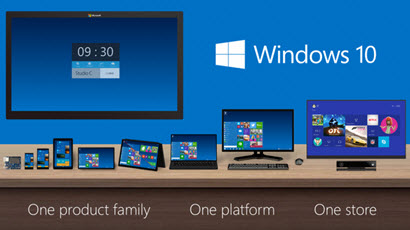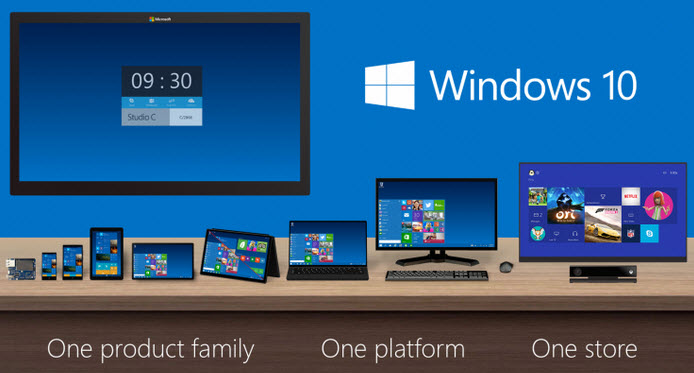What’s in a number, right? Apparently, to Microsoft anyway, the numbers game is one of critical importance. While most rumors regarding new features in the next iteration of Windows have been spot on, the name guessing game has turned out to be way off the mark. In case you may have missed the news, Microsoft has decided to call its latest operating system Windows 10 and not Windows 9, which would have been the logical progression (7>8>8.1>9), and was also most pundits’ best guess.
So why did Microsoft skip Windows 9 and go straight to Windows 10? If you read through Microsoft’s announcement on the official Windows Blog you will see that it is littered with clues, including continual re-iteration of the term “new”:
- One way to look at it is that Windows is at a threshold :-). It’s time for a new Windows
- This new Windows must be built from the ground-up
- Windows 10 represents the first step of a whole new generation of Windows
You don’t need to be Einstein to work out that this “new beginning” approach from Microsoft is designed specifically to create as much distance between Windows 8 and the latest Windows as possible, and by ignoring naming protocol and skipping past 9, Microsoft is hoping to re-enforce that perception – 10 being further away from 8 than 9 is.
While the new name might not make much sense arithmetically it does make perfect sense logically. Had Microsoft followed the natural progression and chosen Windows 9, those who have already taken a dislike to Windows 8 would likely see at as just more of the same.
Current statistics available through NetMarketShare (as at 30th September) show adoption rates for Windows 8/8.1 still lagging way behind expectations, accounting for a mere 13.8% of Windows overall market share. Only half that of the now out-of-date and unsupported XP (26.86%) and way behind the popular Windows 7 (59.3%). Opting for the name Windows 10 is obviously an attempt to encourage disgruntled users to take another look and hopefully (from Microsoft’s point of view) like what they see and upgrade.
(*Percentages shown in the screenshot above relate to overall market share, including Mac and Linux – I have recalculated the percentages to reflect Windows market share only).
History Repeating?
- If you remember rightly, Microsoft started off using numbers to define Windows versions – Windows 1, 2 and then 3.
- Then, in 1995, they switched to proper names – Windows 95 , NT, 98. 2000, ME, XP, Vista.
- Then, after Vista’s dismal failure, lo and behold, MS surprised everyone by reverting back to numbering again with the introduction of Windows 7.
Naming the new OS Windows 10 is, in my opinion, history repeating itself, just Microsoft’s way of distancing the failure from the new. Or at least creating a perception of same.
Crazy Theories?
Of course, it didn’t take long for the hypotheticals to emerge. One popular theory is that because nine is pronounced the same as the German for no (nein), naming the new operating system ‘9’ would have had a negative connotation… Windows, No!
Another suggestion is that Microsoft opted for Windows 10 in order to maintain parity with Apple’s Mac OS X (X being the Roman numeral for 10).
You have to admit, the number ten does have a positive ring to it, thanks largely to the commonly used 10-point ranking system (where 10 is always best) – ten out of ten.
Whatever the reasoning, naming the new operating system ‘Windows 10’ makes perfect sense to this little ole Windows user… a “new beginning” indeed. Then again, I’ve been very happy with Windows 8 and 8.1, maybe I’m just easily pleased.
http://youtu.be/84NI5fjTfpQ


Hi Jim,
Windows XP, now Windows 10 with the ‘P’ dropped??
“Hopefully more popular than the extremely popular XP”……. way of thinking, a different ‘beginning on a new track’.
Regards,
Jonno.
P off the P and all you’re left with is the X = 10. Hadn’t thought of that one Jonno.
You have an inventive mind my friend. 🙂
A lot of people I know think that the even numbered versions of Microsoft products are always garbage and wait for the odd numbered version before upgrading. So Microsoft is trying to confuse people again by yet again giving the odd numbered version an even number (Windows NT4 was the third version of the Windows operating system – Windows NT 3.1 was the second version and OS/2v1 was the first version m- The Windows 1,2 and 3 referred to in the article were graphical interfaces for DOS not operating systems).
You are correct Stephen, Windows 1, 2 and 3 were actually more Operating Environments than Operating Systems.
Thanks for pointing that out, I’ve edited the article’s wording accordingly.
Cheers… Jim
Just maybe, Microsoft is considering 8.1 as 9. Kinda makes sense. They do do things differently than most people would.
“Of course, it didn’t take long for the hypotheticals to emerge. One popular theory is that because nine is pronounced the same as the German for no (nein), naming the new operating system ‘9’ would have had a negative connotation… Windows, No!”
Sort of like selling the Chevy Nova in Hispanic countries. No va = doesn’t go.
I think it more likely that Microsoft wanted to avoid confusion with Windows 95 and Windows 98.
I’m a bit late in here but thought I’d mention one other possible reason alongside the new beginning is apparently windows 9 might have caused problems with some old programs due to the way they are coded as they use windows 9 related to 95 and 98 as shown here:
“if(version.StartsWith(“Windows 9″))
{ /* 95 and 98 */ } else {”
http://www.techradar.com/news/software/operating-systems/microsoft-apparently-skipped-windows-9-name-due-to-third-party-code-conflict-1267580
I read that theory myself Peter. Personally, I think it’s a load of cr*p.
Apart from the fact that Windows 95 and 98 haven’t been supported by the majority of software developers for eons now anyway, how difficult would it be to just remove the two short lines of code?
Besides, I seriously doubt MS would let anything like this dictate its naming policy, when has MS ever been concerned with backwards compatibility?